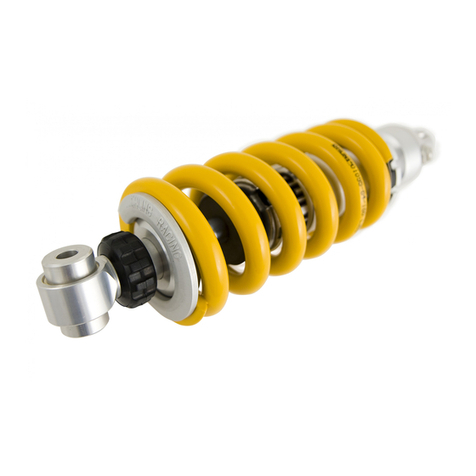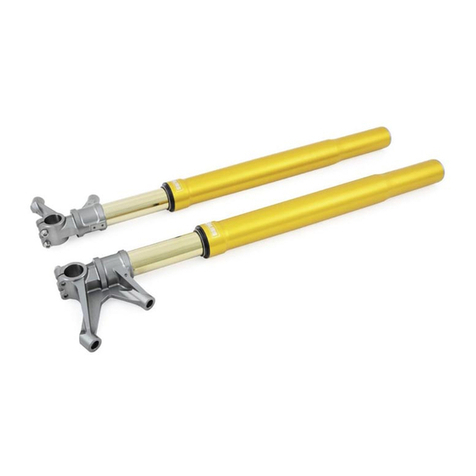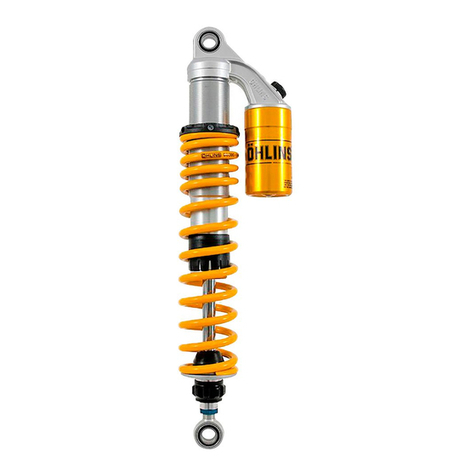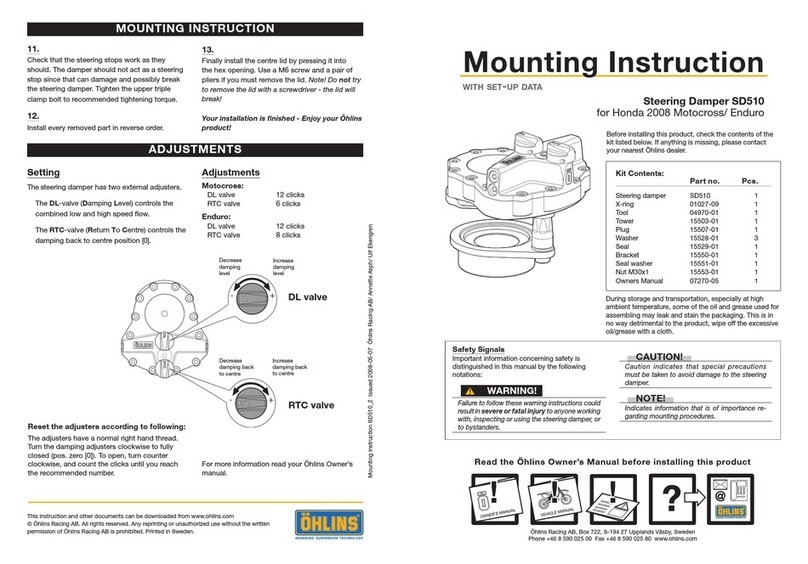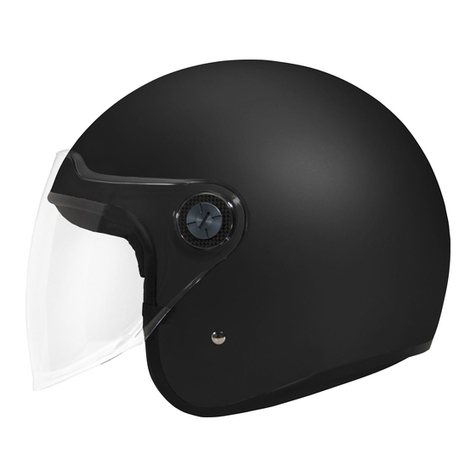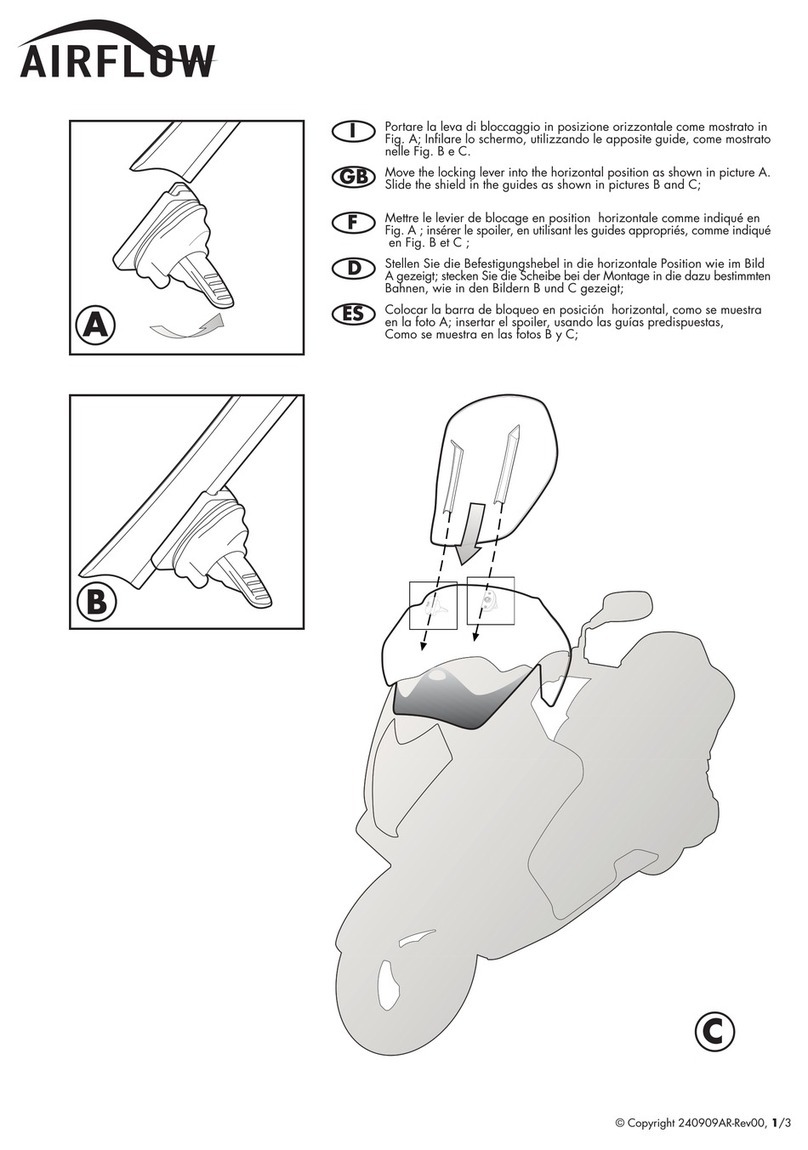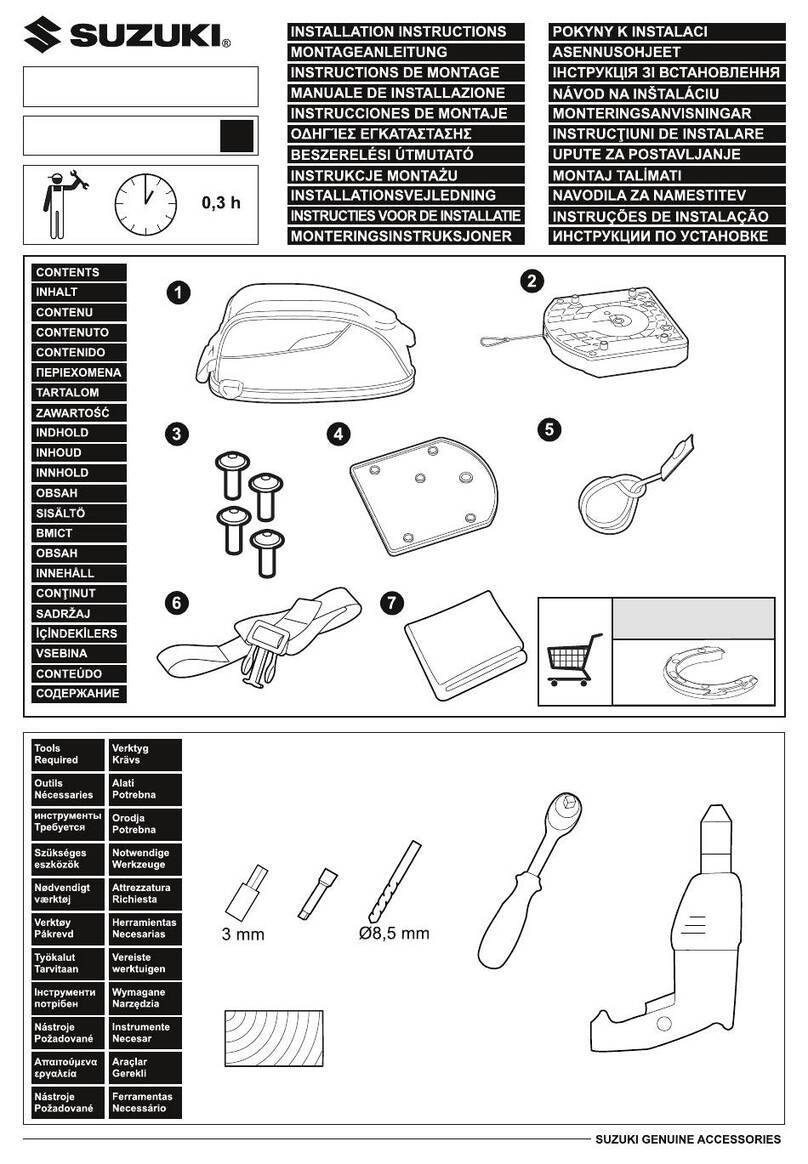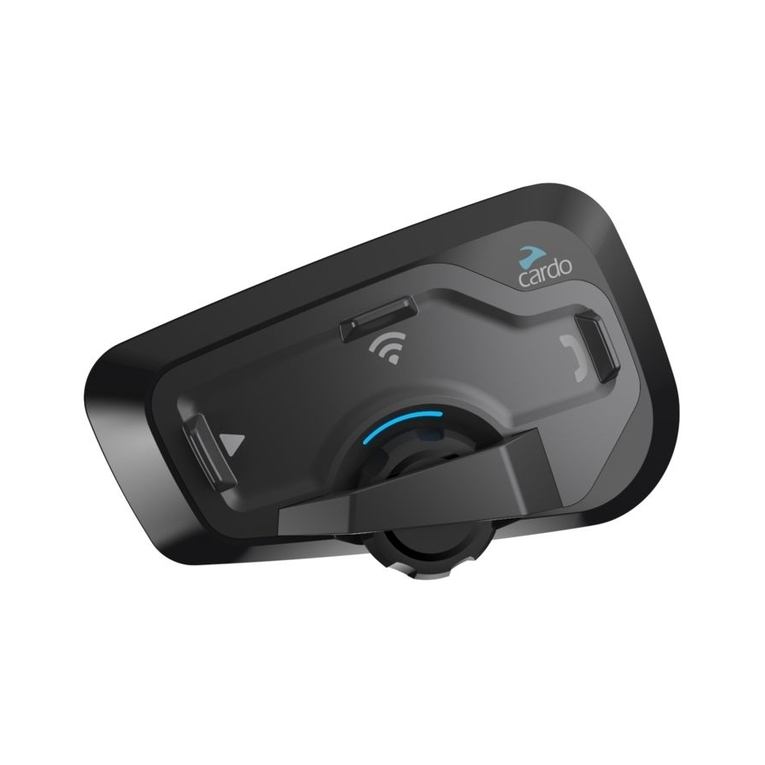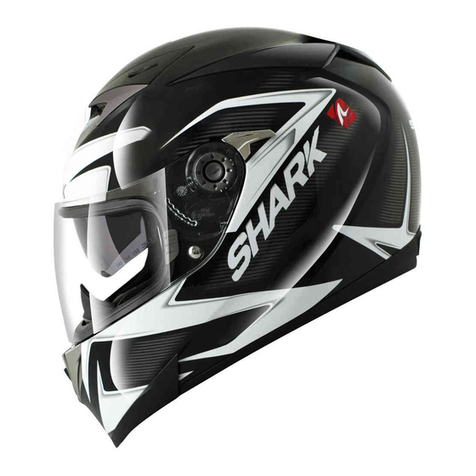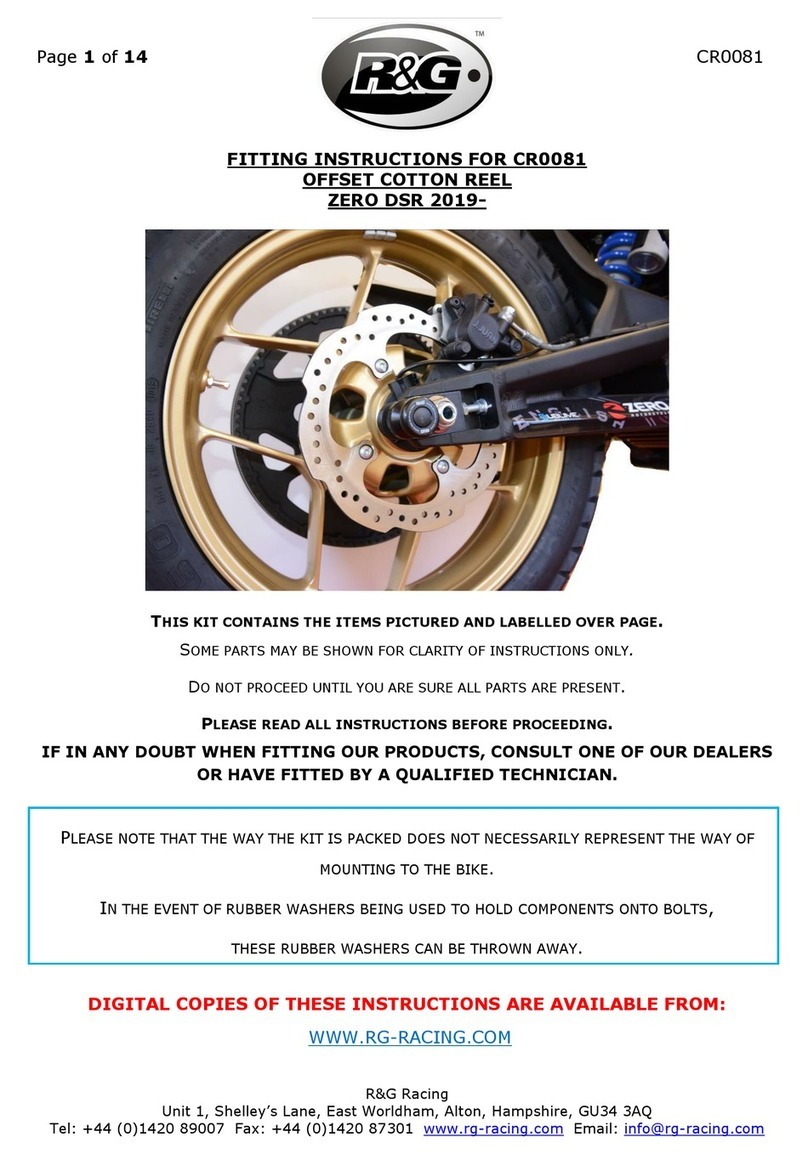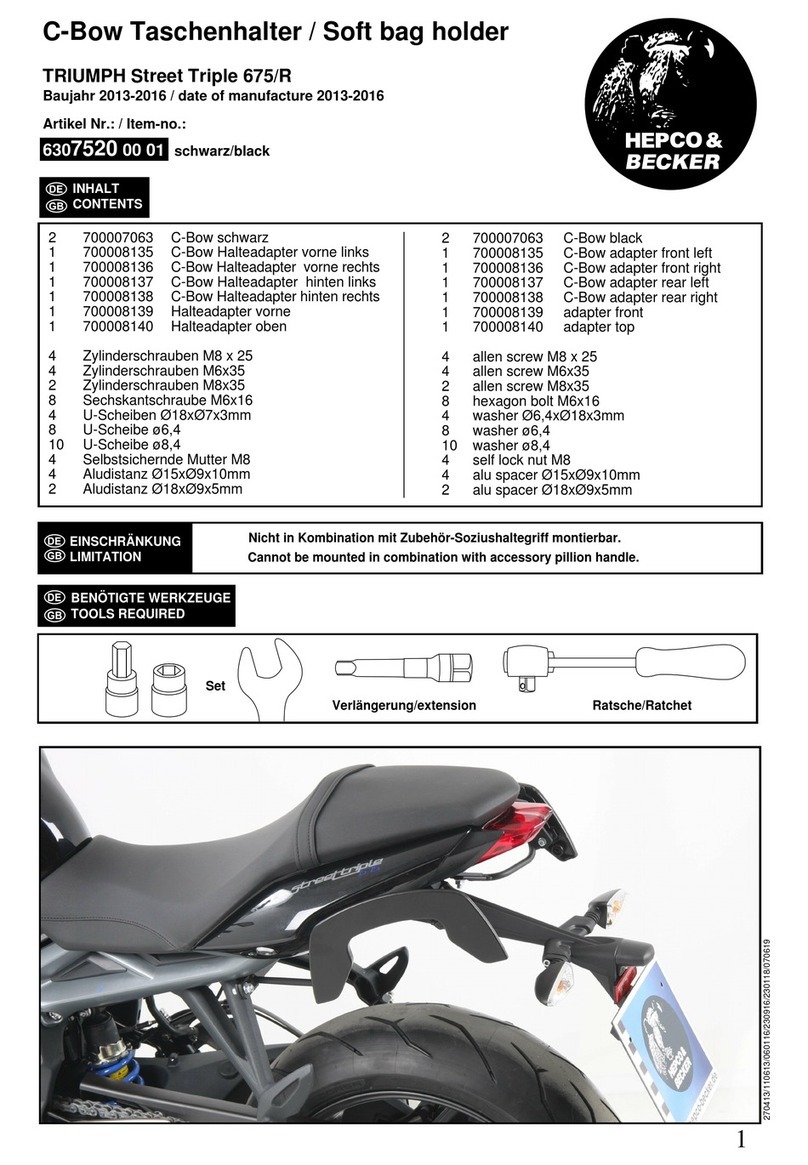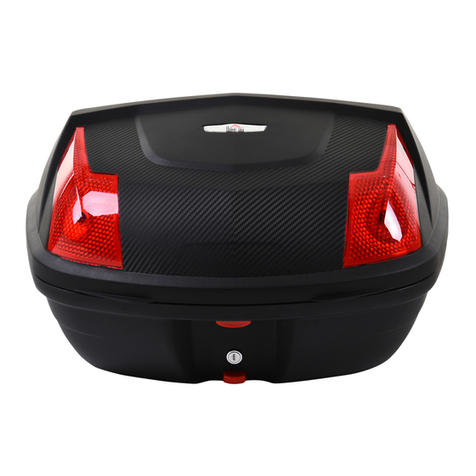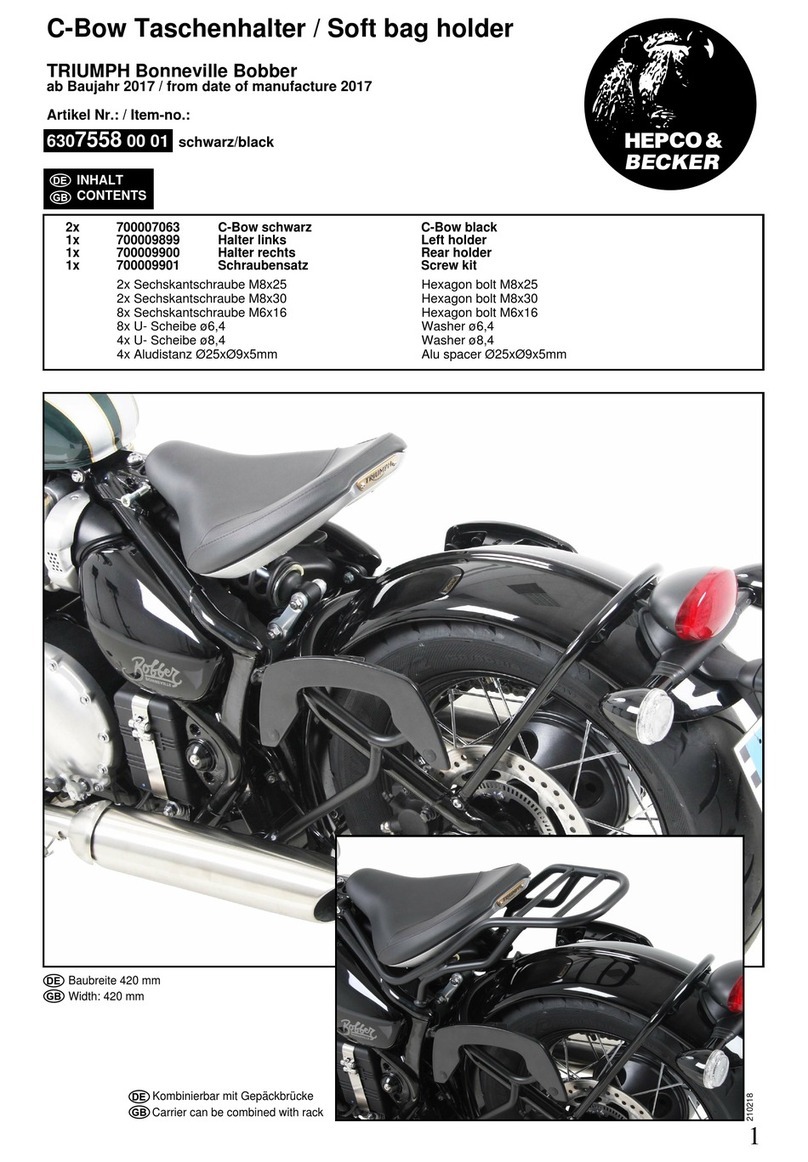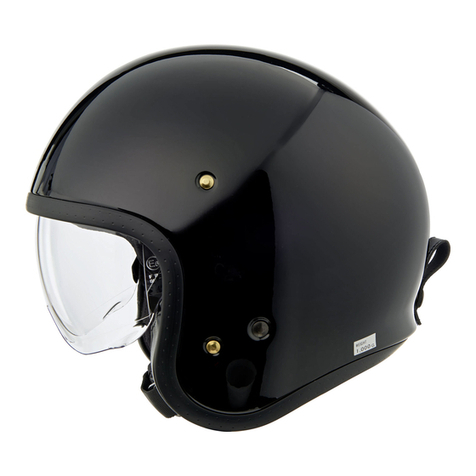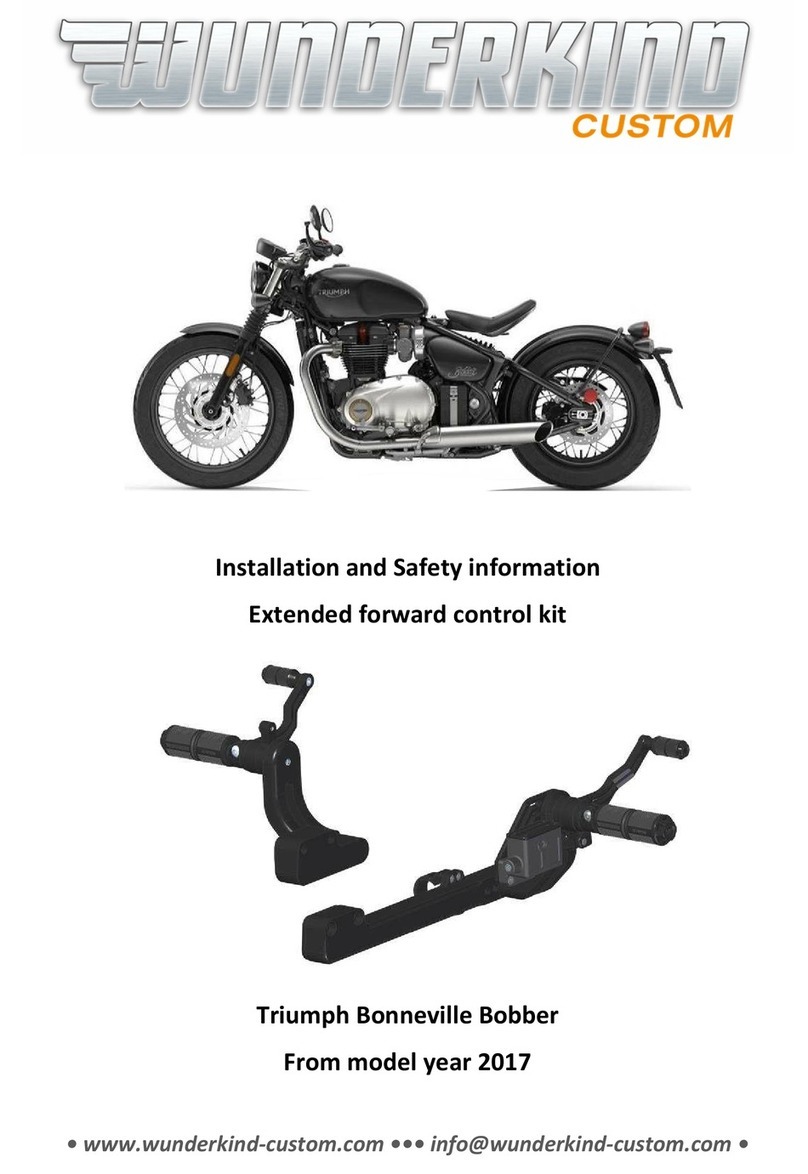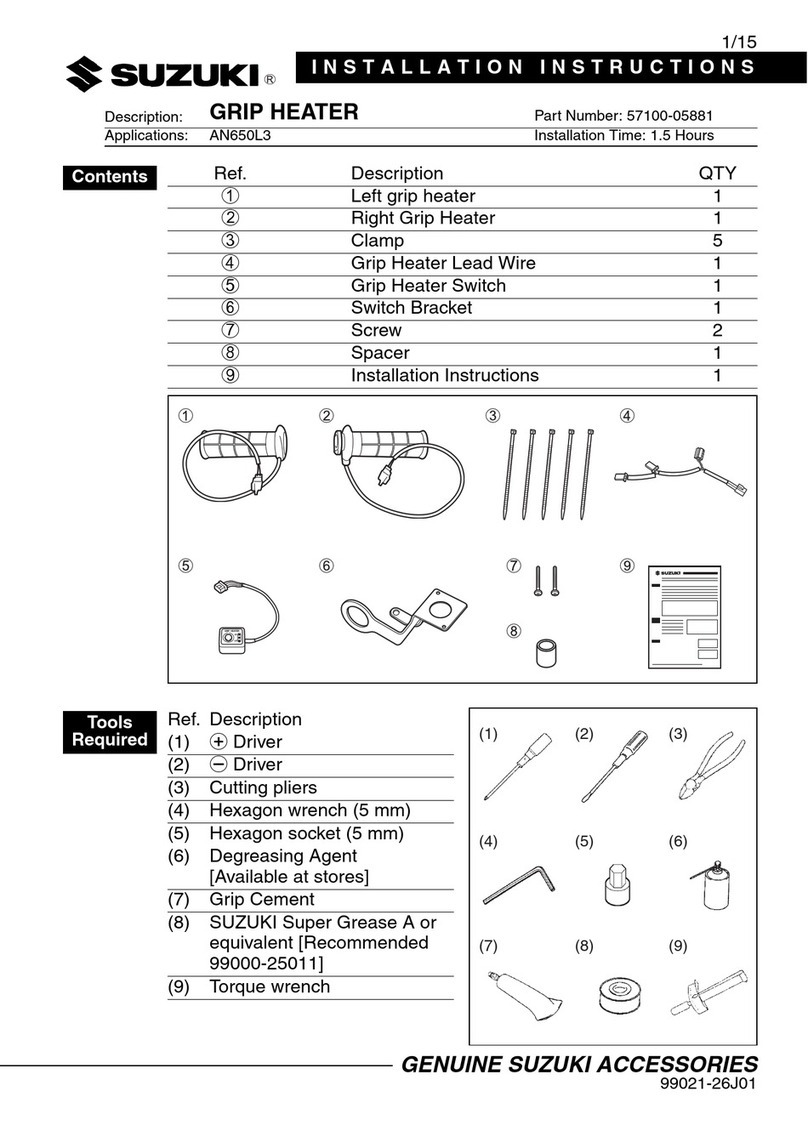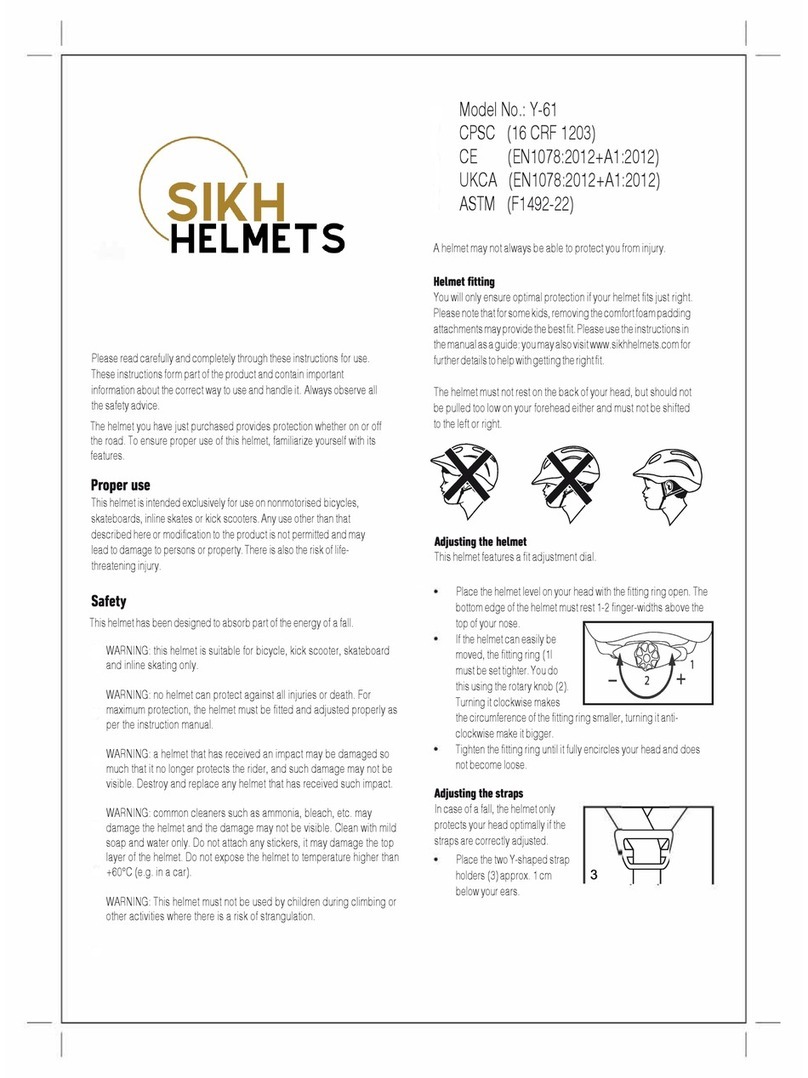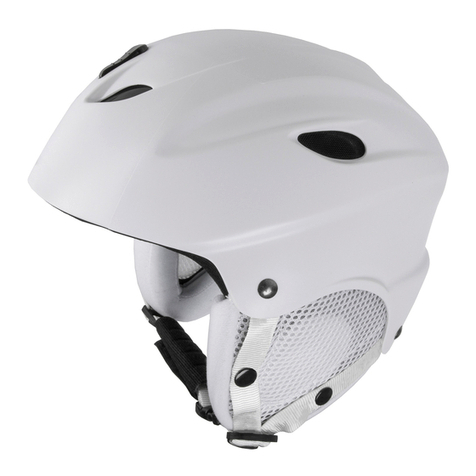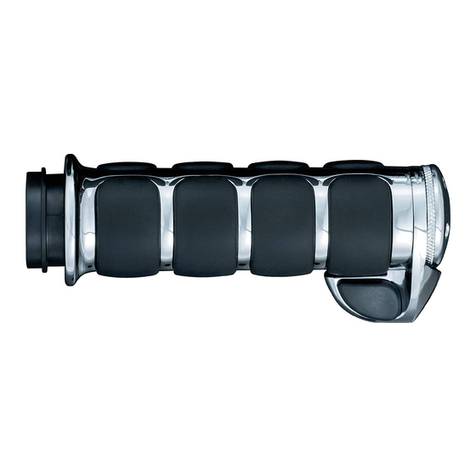Ohlins 225 TM User manual

1
Owners Manual
Öhlins motocross front forks 225 TM
Including:
Setting up
your bike
Fine-tuning
Service
the fork
General
handling set-up
Technical info
Spare parts

2
Safety signals
Important information concerning safety is
distinguished in this manual by the
following notations:
The Safety alert symbol means:
Caution! Your safety is involved.
WARNING!
Failure to follow warning instructions
could result in severe or fatal injury
to anyone working with, inspecting or
using the suspension, or to bystanders.
CAUTION!
Caution indicates that special pre-
cautions must be taken to avoid dam-
age to the suspension.
NOTE!
This indicates information that is of
importance with regard to procedures.
Introduction
All of Öhlins advanced suspension products are
adapted to the brand and model. This means that
length, travel springaction and damping charac-
teristics, are tested individually just for the
motorcycle that you have decided to fit with
Öhlins suspension.
Before installation
Öhlins Racing AB can not be held responsible for
any damage whatsoever to shock absorber or
vehicle, or injury to persons, if the instructions for
fitting and maintenance are not followed exactly.
Similarly, the warranty will become null and void
if the instructions are not adhered to.
© Öhlins Racing AB.
All rights reserved.
Any reprinting or unauthorized use
without the written permission of
Öhlins Racing AB is prohibited.
Printed in Sweden.
WARNING!
1. Installing a front fork, that is not approved by
the vehicle manufacturer, may affect the stability
of your vehicle. Öhlins Racing AB cannot be held
responsible for any personal injury or damage
whatsoever that may occur after fitting the front
fork. Contact an Öhlins dealer or other qualified
person for advice.
2. Please study and make certain that you fully
understand all the mounting instructions and
the owners manuals before handling this front
fork kit. If you have any questions regarding
proper installation procedures, contact an
Öhlins dealer or other qualified person.
3. The vehicle service manual must be referred
to when installing the Öhlins front fork.
NOTE
Öhlins products are subject to continual improve-
ment and development. Consequently, although
these instructions include the most up-to-date
information available at the time of printing, there
may be minor differences between your suspen-
sion and this manual. Please consult your Öhlins
dealer if you have any questions with regard to
the contents of the manual.
Contents
Safety signals ................................................ 2
Introduction ................................................... 2
Tuning the suspension ................................... 3
Design ........................................................... 3
Settings ......................................................... 4
Setting the spring preload ............................. 4
Fine tuning the bike ....................................... 5
Preload adjustment ....................................... 7
Changing springs .......................................... 9
Technical information ................................... 10
Exploded drawing ....................................... 11
General handling set-up .............................. 12
Maintenance ................................................ 13

3
Tuning the suspension
Motorcycle road holding qualities
All motorcycles are designed with a suspension
geometry that includes height and fork angle. The
changing of components can affect this and it is
therefore essential that both the rear and the front
ends match each other.
Changing to Öhlins suspension gives optimum
performance only when both the front fork and
the rear suspension interact properly. It is of the
greatest importance that the front and rear loaded
height are within the specified values.
In the mounting instruction, see section: Setting
the spring preload.
trapped above the oil) that work together with
the “real“ spring. You adjust the air-spring by
raising or lowering the oil level in the legs.
By using different combinations of springs and
air-springs you can alter the characteristic of the
fork. For example, a soft spring in combination
with a small air-spring (high oil level) makes the
fork progressive, see “Fine-tuning the bike“.
Marking
All Öhlins front forks are marked. You will find the
part number on the inside of the fork bottom.
Design
Öhlins new up-side-down (USD) front fork is de-
signed to combine the advantages of comfort-
able, safe conventional forks and rigid, light USD
forks. The result is a unique combination of be-
ing rigid, precise in corners and during hard brak-
ing yet comfortable, forgiving when “over-land-
ing“ and in big bumps.
Your new Öhlins USD front fork has aluminium
outer legs and 46 mm steel inner legs, with a
polished surface for lowest possible friction.
The new USD fork features the Öhlins cartridge
damping system.
The fork is fully adjustable with external adjuster
for compression- and rebound damping.
The compression adjuster is located at the bot-
tom of the fork leg, fig 1, the rebound adjuster at
the top, fig 2.
Spring preload is adjusted with washers, fig 3,
and optional springs are available to suit differ-
ent tracks and riders.
In the legs there are also “air-springs“ (the air
Recommended settings
The front fork in your kit is adjusted to the Öhlins
recommended setting for your bike, see “Mak-
ing adjustments“. We advise you to use this as
your start setting.
1.
The compression adjuster is
located at the bottom of the
fork leg.
2.
The rebound adjuster
is located at the top of
the fork leg.
3.
Spring preload is adjusted
with washers and optional
springs are available.

4
Settings
Basic settings
Always ensure that the basic setting made by
Öhlins is correct. It is adapted to the make and
model (in its original state) and for a rider of
average weight.
WARNING
Incorrect spring action can give a fork angle that
is too steep or too flat.This in turn will give a
tendency for oversteering or understeering, which
could seriously affect the handling characteristics
of the motorcycle.
The original setting of the shock absorber, when
delivered from Öhlins, should always be a base
when the settings are changed by use of the
adjustment devices.
Recommendations:
The difference should not deviate from the
following sizes, if no other recommended settings
are given in the Mounting instructions:
Free sag: (R1-R2), (F1-F2)
Rear: MX/Off-Road 30±5 mm
Front: MX/Off-Road 30±5 mm
Ride height: (R1-R3), (F1-F3)
Rear: MX 100±5 mm
Off Road 30% of the total stroke
Front: MX/Off-Road 80±5 mm
Setting the spring preload
1. Measuring:
Preload on the spring/springs is very important,
because it affects the height of the motorcycle and
the fork angle. Consequently, handling characteristics
can be changed, even negatively. Proceed as follows
(it will be much easier if done by two persons):
•Place the motorcycle on a stand, so the
front fork and the rear end are in fully
extended position.
•Measure the distance, eg, from the
lower edge of the rear mudguard or
from a point marked by a piece of tape,
immediately above the rear wheel axle,
to the wheel axle (R1).
•Make a similar measurement on the front axle,
e.g., from the bottom of the upper fork crown
to the front wheel axle (F1).
•Allow the motorcycle (without rider) to
apply load on the springs and repeat the
measuring procedure (R2, F2).
•Then take the same measurements with
the rider and equipment on the
motorcycle (R3, F3). It is important that the rider
has a correct riding posture, so that the
weight is balanced on the front and rear
wheel in the same way as when riding.
Bike on a stand.
F1
R1
Bike on the ground.
F2
R2
Bike with rider on.
F3
R3

5
Fine-tuning the bike
Learning how to use the adjusters will take time
but you quickly appreciate them once you know
the tricks. Even the specialists sometimes need
a specialist!
With the adjusters you optimize the suspension
for your riding style and the track you are com-
peting on.
The same basic guide lines goes for both the
front fork and the rear shock absorber.
Too much compression damping will give you a
harsh ride as your bike “jumps“ along the track.
With too much rebound damping your bike will
have difficulties with several bumps in a row. The
suspension will not extend fast enough between
bumps, your bike will ride lower and lower and
eventually the suspension will bottom!
External adjusters
On the Öhlins front fork the adjusters are bleed
valves, totally separated from each other.
The compression bleed valve controls the flow
in the cartridge tube during the compression
stroke, the rebound bleed valve the flow during
the rebound stroke.
CAUTION!
Using too much force when closing the adjust-
ers will destroy important sealing surfaces.
Both the adjusters have a normal right-hand
thread.
Click position zero (0) is when the adjusters are
turned clockwise to fully closed.
The adjustment range, from fully closed until
maximum open valve (anticlockwise), is 20 clicks.
In order not to click in the wrong direction; al-
ways first close the adjuster, then dial-in the new
setting.
Making adjustments
To make improvements using the adjusters, it is
important to understand the function of the front
fork and the shock absorber and through testing
learn how they effect the handling of your bike.
Make sure that you have the correct springs and
the correct spring preload before making any ad-
justments. And always start with the Öhlins rec-
ommended settings:
NOTE!
See mounting instruction for recommended set-
tings.
NOTE!
Higher click numbers give less damping force.
When making adjustments; keep notes, make
adjustments one at a time... and in small steps.
The adjusters should normally not be adjusted
in steps of more than 2 clicks at a time and not
outside the usable click range.
When you think you have made an improve-
ment, go back to what you started with and dou-
ble check to be sure. Pay attention to changes in
Compression stroke Rebound stroke
Flow in compression valve Flow in rebound valve Flow in compression valve Flow in rebound valve

6
conditions like tires, temperatures etc.
In general, compression damping changes
should be used to influence the bike’s stability
and response, while rebound damping changes
should be used to influence comfort and trac-
tion.
When you need more damping force, you should
mainly try to increase compression damping and
use as little rebound damping as possible.
This usually means that you gain comfort and
performance in handling.
Oil level adjustment
As the air trapped between the oil and the top
nut acts as an air-spring, a change in oil level will
effect the damping forces. Not in the early stage
of fork travel, but a great deal in the later stage.
A general description of how the oil level/air-
spring effects the damping forces are shown in
fig 5.
The air-spring gives the Öhlins USD fork a pro-
gressive spring rate, preventing it from bottoming
out hard.
By using different combinations of springs and
oil levels/air-springs you can alter the character-
istic of the fork and tailor it to suit different tracks
and conditions.
CAUTION!
The oil level must be the same in both front fork
legs.
Riding a bike with different oil levels will cause
instability.
When the oil level is raised:
The air-spring in the later half of travel is strong,
and thus the front fork hard.
When the oil level is lowered:
The air-spring in the later half of travel is soft,
and thus the front fork soft.
CAUTION!
Adjust the oil level with the fork leg fully com-
pressed and no preload washer nor spring in-
stalled.
NOTE!
See mounting instruction for recommended oil
level.
The oil level is measured from the top of the outer
leg, with the top nut off, see fig 6.
A change in oil level should be made in small
steps. We recommend a change of 5 mm at a
time and not outside the range of 90-130 mm.
Oil level
6.
Oil level is measured
from the top of the
outer leg, with the top
nut off,the fork fully
compressed and no
preload washer nor
spring installed.
Oil level
500
450
400
350
300
250
200
150
100
50
0
F
o
r
c
e
k
g
f
Stroke mm
020 40 60 80 100 120
Oil level 100 mm Oil level 110 mm Oil level 120 mm Oil level 130 mm
Force
Stroke
Air spring
5.
A change in oil level
will effect the damp-
ing forces, not in the
early stage of fork
travel but a great
deal in the later
stage.

7
Preload adjustment
1
Put the bike on a stand and loosen the screws in
the fork top crown that hold the fork legs.
NOTE!
On most MX-bikes you have to take of the handle
bar before you can unscrew the top cap.
Remove the adjustment wheel and the springs
and balls of the adjuster.
2
Unscrew the top cap, use tool. (1860-01).
Put a box under the front wheel so that the
springs are visible.
3
Remove the top cap from the damper rod ex-
tender. Use a 17mm wrench, and tool (1860-01).
Adjustment
wheel
Balls and
springs
Tool (1860-01) Top cap
17 mm
wrench
Damper
rod assy
Damper rod
extender

8
4
Remove the spring support and the original spring
preload washer.
Install a new preload spacer to achieve the right
static sag.
5
Fit the spring support and the top cap and refit
the adjustment wheel.
For tightening torques, please see your bike's
work shop manual.
NOTE!
The top nut only have to be tightened by hand
without extending tool.
Spring
support
Original
pre-load
washer
New
pre-load
washer
Adjustment
wheel
Top cap
Spring support

9
Changing springs
6
Loosen the screws that hold the fork legs in the
upper fork crown.
With the fork leg still tightened in the lower fork
crown unscrew the top cap, tool (xxxxx-xx).
Loosen the screws that hold the fork legs in the
lower fork crown.
Remove the fork legs from the motorcycle and
fasten it in vice with soft jaws.
Follow instructions 1-4 * on previous side and
remove the spring.
* But do not install the spring support spacer.
7
NOTE!
Closing the compression- and the rebound valves
will keep the damper rod extended making it easier
to install the new spring.
Pull out the damper rod as far as possible.
Close the compression and the rebound valve
(clockwise).
8
Install the new spring*.
* Check the free length of the spring. Original
length is 487 mm. If the spring length is under
460 mm the spring must be changed.
Follow instruction 5 on previous side.
Adjust the compression- and the rebound valves
according to specification card.
Fit the fork legs on the motorcycle.
For tightening torques, please see your bike's
work shop manual.
L ≥460 mm
Compression
adjuster

10
Technical specifications
Fork lengths and diameters
Front fork Motorcycle Length (L)
ØA ØB
FG 225 TM 938 mm
53,9 mm 58,4mm
Rebound and compression adjustment
Refer to mounting instruction for set-up data.
Maximum open rebound and compression valve:
20 clicks.
Free Spring Length:
All forks: 467 mm (service limit 460 mm).
Spring preload:
Maximum allowed adjustment
range 3-13 mm (with washers).
Spring rate:
All forks: 2328-41 4,1 N/mm.
2328-43 4,3 N/mm supplied
Optional spring rate:
2328-39: 3,9 N/mm.
2328-45: 4,5 N/mm.
2328-47: 4,7 N/mm
ØA
ØB
L
70
300
200
Oil level:
See mounting instruction for recommended oil
level.
Adjustment range 90-130 mm.
CAUTION!
Use only Öhlins high performance front fork fluid
No. 5 (1305-01).
Tighten torque:
Triple clamp bolt: See your bike's work shop
manual.
Compression valve: 65 Nm (Base valve).
Cylinder tube lid (cartridgetube): 65 Nm
Compression valve, 8 mm nut 8 Nm.
Rebound valve, 8 mm nut 8 Nm.
Grease:
Öhlins Front Fork grease 00146-01
(Red grease).
Service Intervals:
Every 20 hours.

11
6
7
8
9
10
13
14
15
18
19
20
22
22
17
10
11
1
2
3
4
5
21
16
24
25
26 23
25
1
4
5
7
23
9
8
6
10
11
12
13
14
15
16
17
18
19
20
21
27
28
29
31
32
33
34
35
37
38
39
40
42
43
45
44
56
22
47
48
49
50
51
52
53
54
46
12
Front fork components
23
24
25
26
30
36
41
55

12
General handling set-up Front suspension.
Front fork travel is not used to its full
capacity. Harsh feeling, front wheel grip is
not satisfactory in bumpy turns.
Suspension too hard.
• Decrease the front fork
compression damping.
• Change to softer springs.
Suspension bottoming, too soft during
entire travel.
Spring too weak or compression damping too soft.
• Increase oil level 5 mm.
• Increase compression damping.
• Change to stiffer springs.
Suspension bottoming, but can handle
smaller bumps.
Damping force not progressive enough.
• Increase the oil level.
Can handle smaller bumps but is too hard
during the last part of the travel.
Damping force is too progressive.
• Decrease the oil level.
Front end feels low, initially feels soft, but is
not bottoming.
The initial spring rate is too soft or spring preload
is too low.
• Increase the spring preload.
Feels harsh over small bumps, but using full
wheel travel.
Too much spring preload or too much compres-
sion damping.
• Increase the oil level or change
to softer springs.
• Decrease the compression
damping.
• Decrease the spring preload.
• Clean the oil seals and scrapers.
Use Öhlins grease 148-01 for
regreasing.
Can handle the first in a series of bumps but
feels hard after a few more bumps. Frontal
grip insufficient in rough and bumpy turns.
Too much rebound damping.
• Decrease the rebound damping.
Front end rebound too fast after a bump.
Front wheel grip insufficient in bumpy
curves.
Not enough rebound damping, or too much
spring preload
• Increase the rebound damping.
• Decrease the spring preload.
Front end ”ploughs”, understeers.
Shallow front fork angle. Front end too high in
comparison to rear end.
• Decrease the front fork
compression damping.
• Raise the fork legs approximately
5 mm in the triple clamp.
• Change to softer fork springs.
Front end unstable at high speed, unstable
when accelerating out of curves.
Front fork angle too steep. Front end too low in
comparison to rear end.
• Lower the fork legs approximately
5 mm in triple clamp.
• Change the front fork springs to
harder ones.
Front end unstable during deceleration.
Front fork angle too steep during braking. Front
end too low or rear end too high.
• Increase the oil level in the front fork.
• Change to harder fork springs.
• Increase the front fork
compression damping.
Front end falls into the curves (over-
steering) especially in sand.
Steep front fork angle. Front end too low in com-
parison to rear end.
• Increase the front fork
compression damping.
• Change to harder springs.
• Lower fork leg approximately
5 mm in the triple clamp.

13
Maintenance
Telescopic front forks depend on a smooth, fric-
tion free action.
Make sure your forks are regularly serviced.
Do not use strong solvents, such as brake
cleaner, to clean the front forks. This will dry out
the seals and the steel tubes and cause friction
or leakage.
After every race:
Clean externally and spray with an
all-purpose oil after washing with
detergent.
Check externally for damage.
Put a little Öhlins green grease (148-01) on the
steel tubes and work it in by pushing the fork up
and down.
Every 20 hours:
Dismantle the fork and check all parts for wear
and damage, replace if necessary, see page 10.

14
Notes

15
Notes

16
07295-13, Issued 02 08 22
The ultimate suspension site.
Find out everything about your suspension.
Download mounting instructions, manuals and brochures.
And a lot more.
Öhlins Racing AB, Box 722, S-194 27 Upplands Väsby, Sweden
Phone +46 8 590 025 00, Fax +46 8 590 025 80
Your Öhlins dealer:
More info
www.ohlins.com
Table of contents
Other Ohlins Motorcycle Accessories manuals
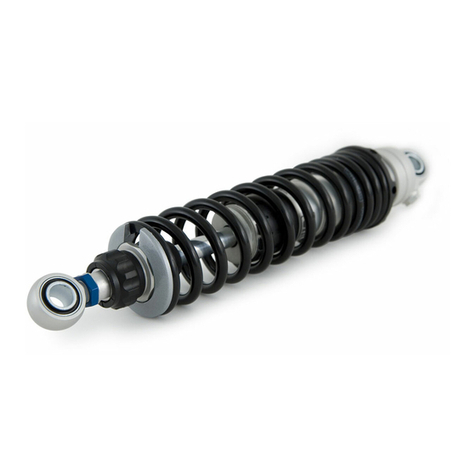
Ohlins
Ohlins HD 159 User manual
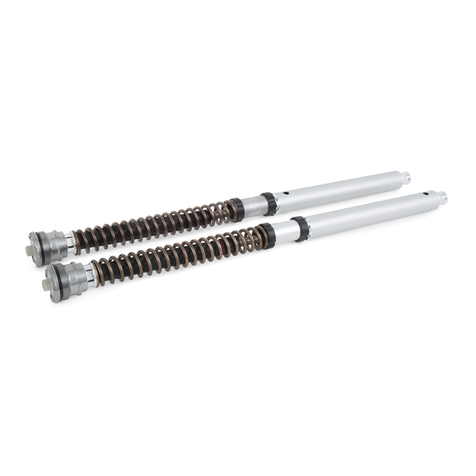
Ohlins
Ohlins FGK 135 User manual
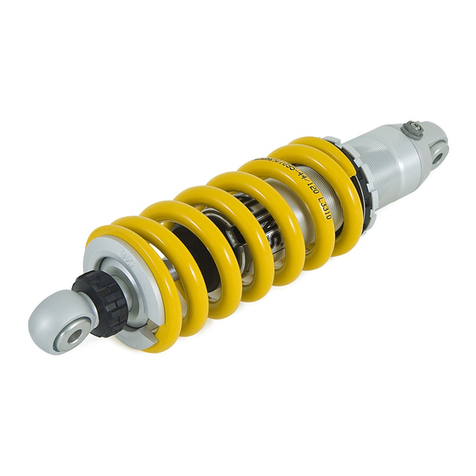
Ohlins
Ohlins KA 037 User manual
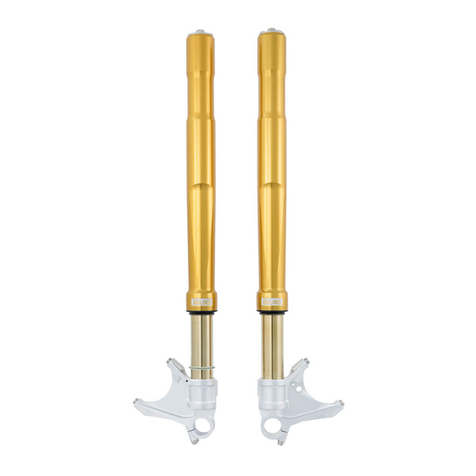
Ohlins
Ohlins FGRT 219 User manual
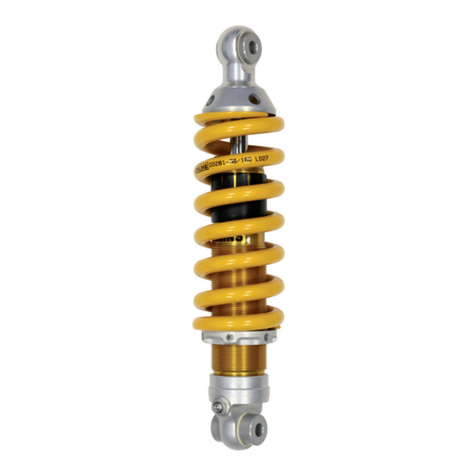
Ohlins
Ohlins HO 944 User manual
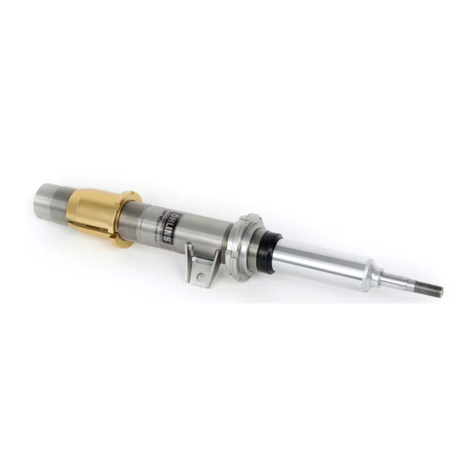
Ohlins
Ohlins BMZ MN01 User manual
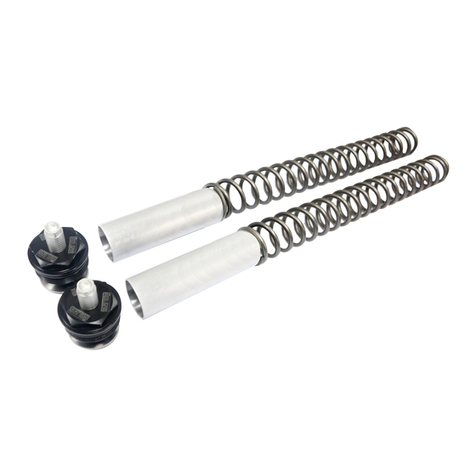
Ohlins
Ohlins FSK 105 User manual
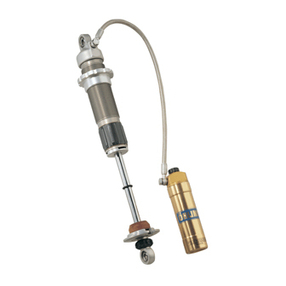
Ohlins
Ohlins FG 470 User manual
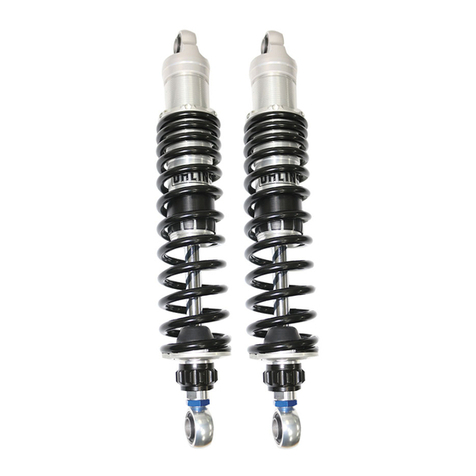
Ohlins
Ohlins TR 628 User manual
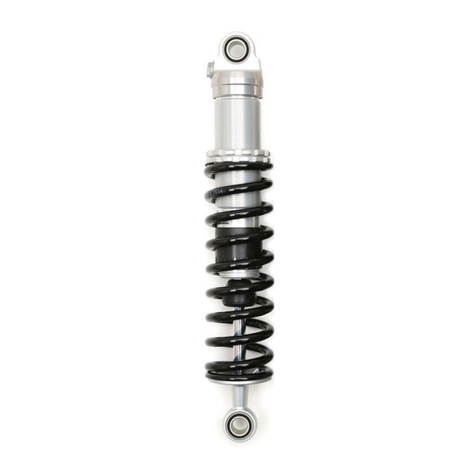
Ohlins
Ohlins HD 022 User manual
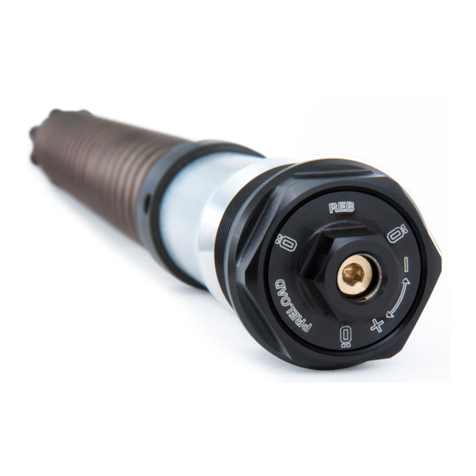
Ohlins
Ohlins FKS 503 User manual
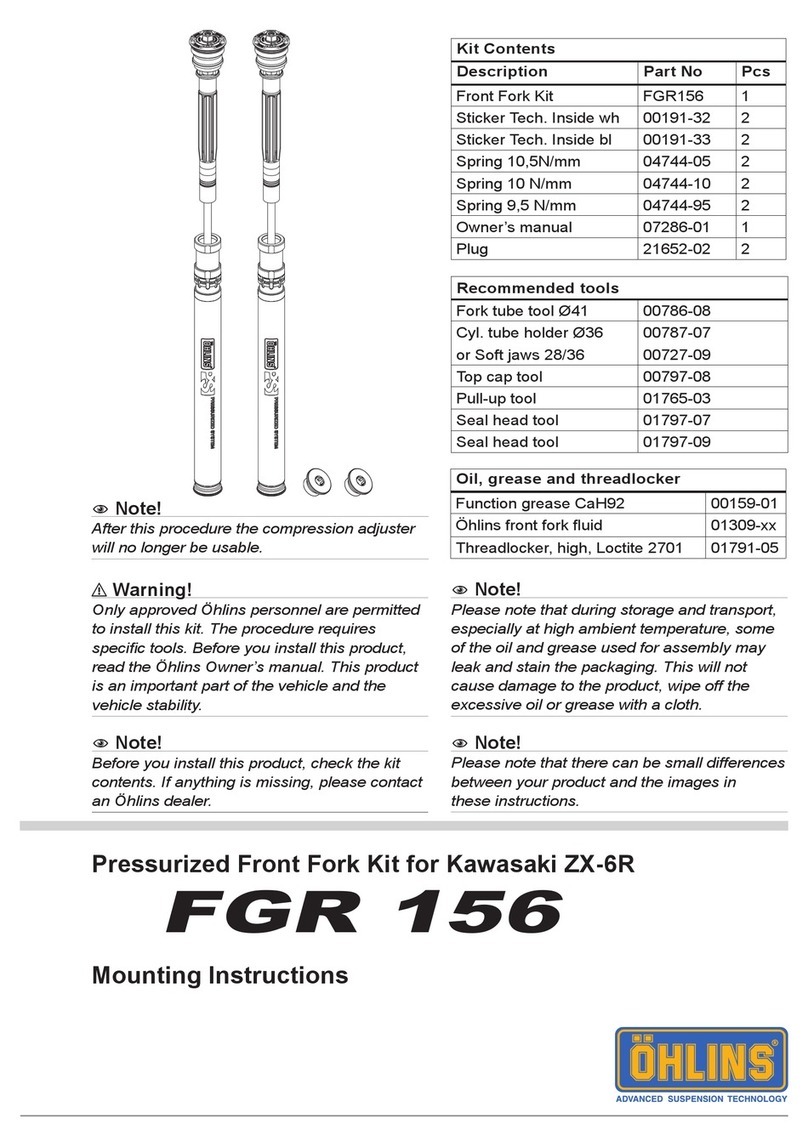
Ohlins
Ohlins FGR 156 User manual
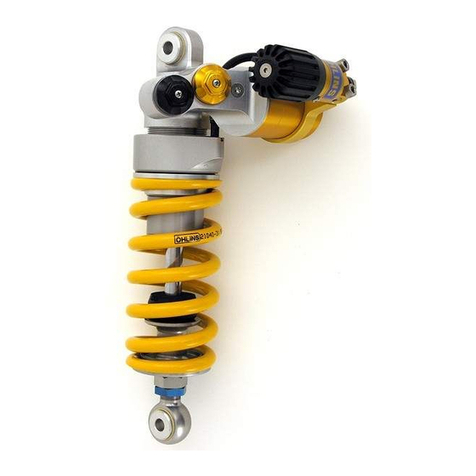
Ohlins
Ohlins AP 840 User manual
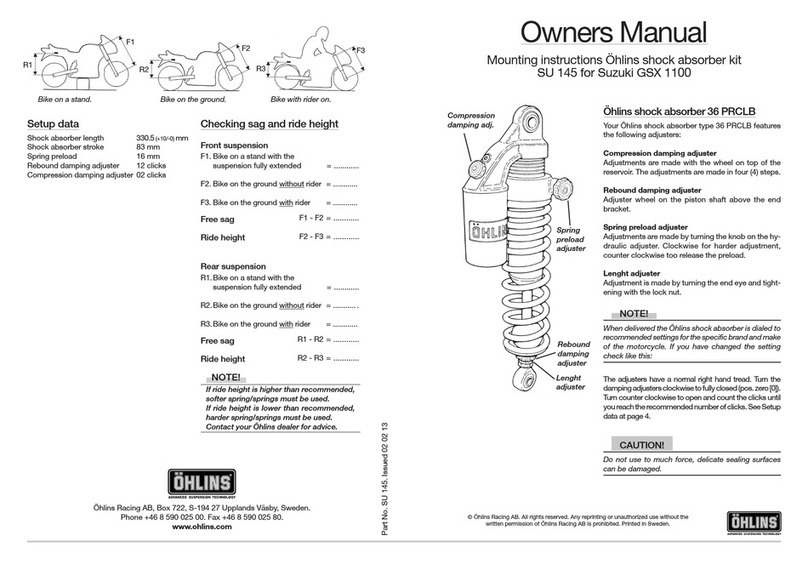
Ohlins
Ohlins SU 145 User manual
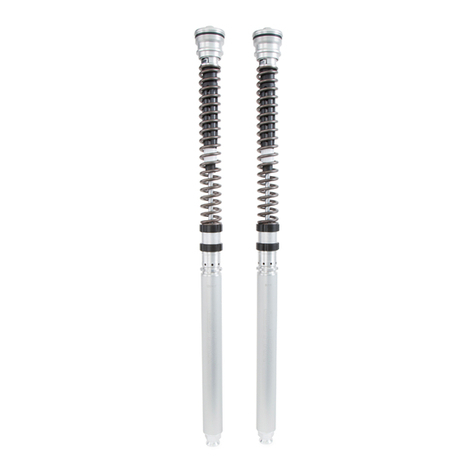
Ohlins
Ohlins FKR 118 User manual
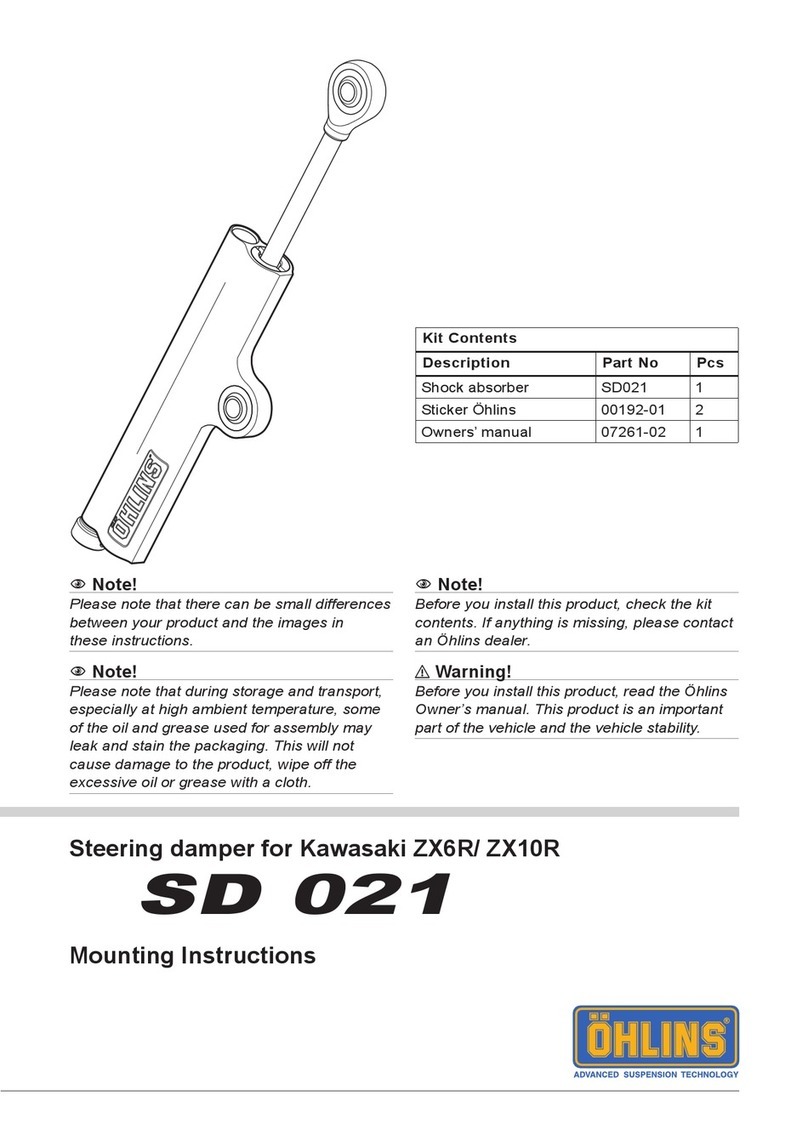
Ohlins
Ohlins SD 021 User manual
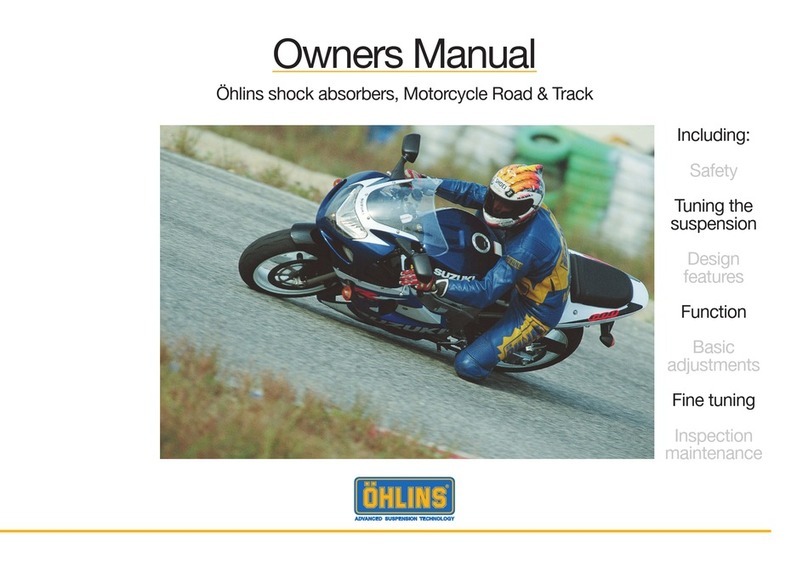
Ohlins
Ohlins Ohlins shock absorbers Motorcycle Road &... User manual
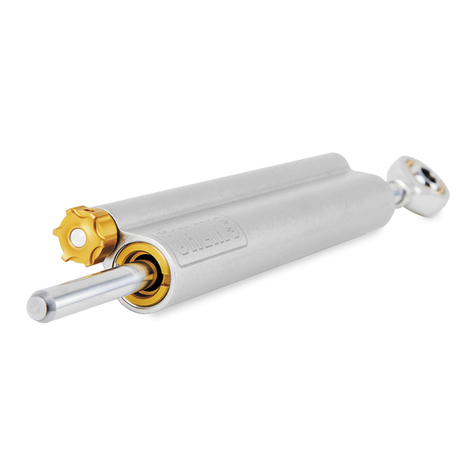
Ohlins
Ohlins SD197 User manual

Ohlins
Ohlins HO 1072 User manual
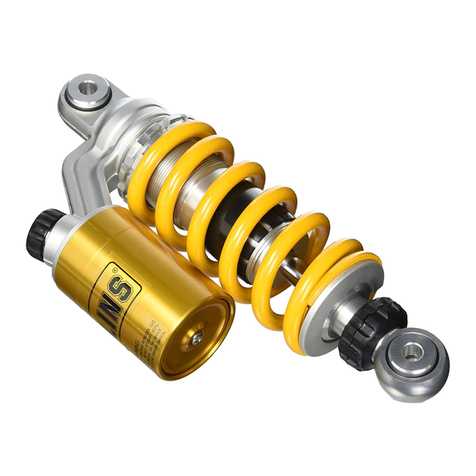
Ohlins
Ohlins HO424 User manual
